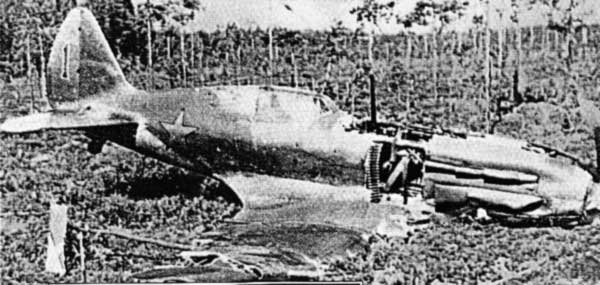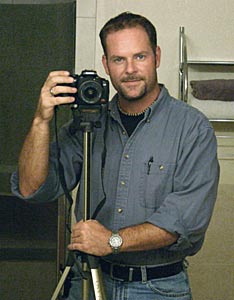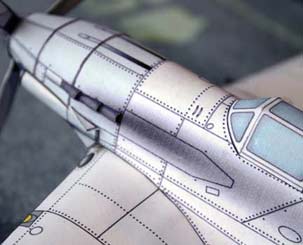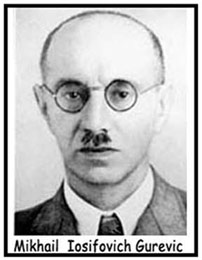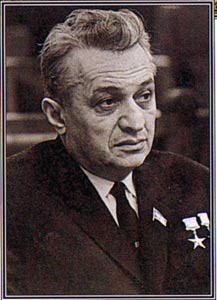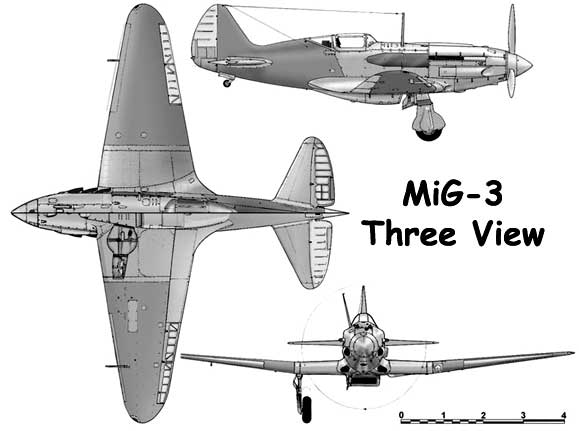


MiG-3 fighter - $$5.95
This is a model of the under-appreciated early WWII Russian MiG-3.The Mikoyan-Gurevich MiG-3 was a Soviet fighter aircraft used during World War II. It replaced the MiG-1 on the production line on 20 December 1940 and was built in large numbers during 1941 before the one factory that manufactured it was converted to produce the Ilyushin Il-2 later that year.
WWII Russian Fighter: Mikoyan-Gurevich MiG-1 through MiG-3
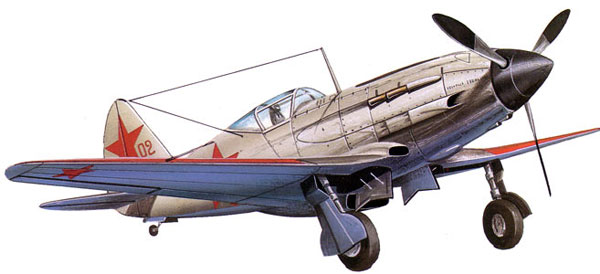
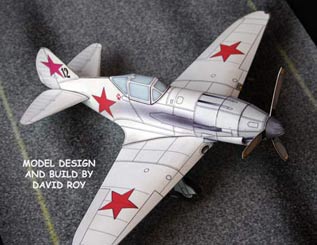
WWII Russian MiG-3 Fighter
Dive into the underappreciated MiG-3, a Soviet high-altitude interceptor from early WWII that evolved from the MiG-1 with improved stability and a powerful Mikulin AM-35A engine, reaching speeds up to 398 mph. Built in over 3,100 units by late 1941, it excelled in air defense and reconnaissance roles despite low-altitude challenges. This easy-to-assemble paper model, priced at $5.95 and designed by David Roy, features quick build time (under two hours), optional landing gear details, and multiple color variants for historical accuracy—perfect for aviation history buffs.
The Mikoyan-Gurevich MiG-3 was a WWII Soviet fighter aircraft of World. It was a development of the MiG-1 in an attempt to curb some of that aircraft's handling problems. Mikoyan and Gurevich made a large number of modifications to the MiG-1 design after field testing revealed a number of dangerous characteristics of the type.
The most significant of these was doubling
the dihedral of the outer wings in an attempt to create more stability,
and lengthening the nose of the aircraft to move the engine and
therefore center of gravity further forward. These changes were
quickly implemented on the MiG-1 production line, and by March
1941, 10 of these aircraft were coming off the production line
every day. It was not long before the type would see combat, claiming
a pair of German Junkers Ju 86 reconnaissance aircraft even before
the start of hostilities between Germany and the Soviet Union.
The MiG-1 had originally been designed as a high-altitude
interceptor, and this is where the MiG-3 excelled as well. The
full circle turn time improved from 26.5 seconds to 23 seconds.
However, most of the combat against the German invasion took place
at very low altitudes, where the aircraft did not stand out at
all. Some attempt was made to put it to use as a ground-attack
aircraft, but it was quickly withdrawn from this role. From Spring
1942 onwards, the MiG-3s were moved from the front line to air-defense
squadrons, some of which flew them for the rest of the war.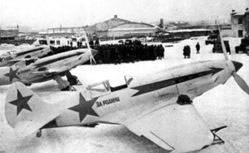
Throughout the rest of the war, Mikoyan and Gurevich continued
to develop the MiG-3 along the high-altitude interceptor
lines that it had originally been designed for, leading to a series
of ever-larger and more powerful prototypes, the I-220 to I-225.
While promising enough, the air war over Germany was demonstrating
that the heyday of the piston engine fighter was over, and no
production order followed.
Between December 1940 and December 1941, more than 3,100 MiG-3s were built.
COOOL
MiG!!! Tell the designer that I'd like a shot at
coloring one. Best regards,
John "wily" Mollison
"A beauty".. Jim Cookson
I finished up the MiG-3 over the weekend and thought I would send you some pictures. It turned out nice ...I used RR
 Silver paper for the nose, as I found in some historical shots
it appears to be bare metal. Another great model! Thanks.
Tim Allen (5/06) Scroll down for Tim's
photos
Silver paper for the nose, as I found in some historical shots
it appears to be bare metal. Another great model! Thanks.
Tim Allen (5/06) Scroll down for Tim's
photos
Hi Chip,
your latest models are great - as can be expected of any new FG releases. I am currently assembling the Fa61 helicopter, not an easy one in 1/72 scale ! It is, however, so odd yet historically important that it should be included in my collection.
Another beauty is the Mig 3, which just begs for some more versions. As a start, I have produced the one attached, Red 02. This particular aircraft is frequently documented as having red upper wings, but recent reports indicate that this should actually be dark green, which is how I finished it. As a sideline to David Roy's model : Russian aircraft rarely had red stars on the upper wings, and the light blue on the underside was quite vivid. There are, however, numerous exceptions to this rule so his version may be 100% correct. Please, feel free to share this version with other modelers. And you can tell them already that other more colorful versions are in the pipeline... Kind regards, Guido Van Roy (5/06) NOTE: All Guido's numerous versions are included in the MiG-3 folder.
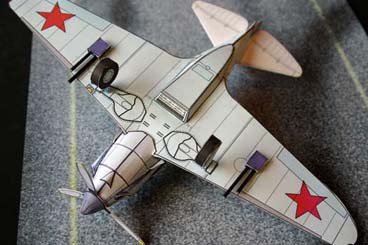
The landing gear can be cut from the wing and bent out. Included with the MiG-3 model, are LG stiffener pieces. |
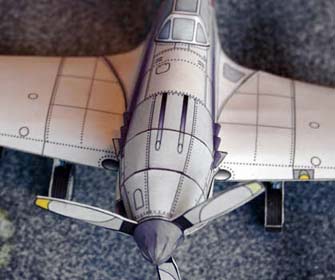 The photos show the MiG-3 on tarmac graphics which is included in the folder |
David Roy is an inspiring artist of many talents and this MiG-3, his first cardmodel, is a good example of his scope and talent. He nailed the dreaded FG
format in one try !!
"The plane assembled in less than two hours and fit well. I'm really bad at putting these things together, so I'm sure most will have a blast with it!" and I hope
she |
|
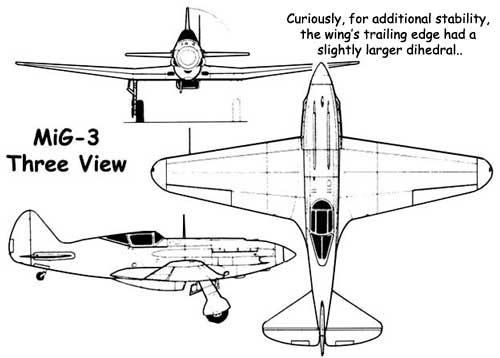
At the time of the German invasion of Russia in
1941, 37 percent of the Soviet
fighter force was equipped with the MiG-1 and MiG-3 fighters.
MiG -3 WWII Fighter
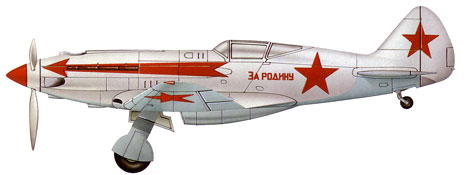
The first wartime generation Soviet fighter was also the first to result from collaboration between two designers who were to become world famous for their long-running series of fighter aircraft: Artem Mikoyan and Mikhail Gurevich. The MiG-l and its successors of the war years were not in absolute terms the best fighters to be produced by the Soviet Union during the course of the Second World War, but, although constructed in fairly small numbers overall, they made a considerable impact on the course of the war.
The MiG-1 prototype flew for the first time in March 1940, and immediately gave proof of excellent performance, particularly in speed greatly superior to that of the various types of Polikarpov fighters which were in service at the time.
The aircraft was a low-wing monoplane, with retractable undercarriage, mixed wood/metal structure and canvas skin. It was powered by a Mikulin AM 35 1,200 hp engine, which drove a three-blade metal variable pitch propeller. It was armed with two 7.62 mm machine guns. one 12.7 mm gun and had a maximum bomb-capacity equivalent to 440 lb. Production was started immediately and 2,100 aircraft were completed before the MiG-1 was replaced by its more modern successor, the MiG-3.
The MiG-3 fighter went into service towards the end of 1941 and its design earned Mikoyan and Gurevich the Stalin Prize for that year, in consideration of the outstanding contribution they had made to the Soviet aeronautical industry. Although it was not an outstanding fighter plane in the strictest sense of the term, the MiG-3 did have certain features which enabled it to be used in the role of a high altitude interceptor, in order to oppose the German fighters of the time.
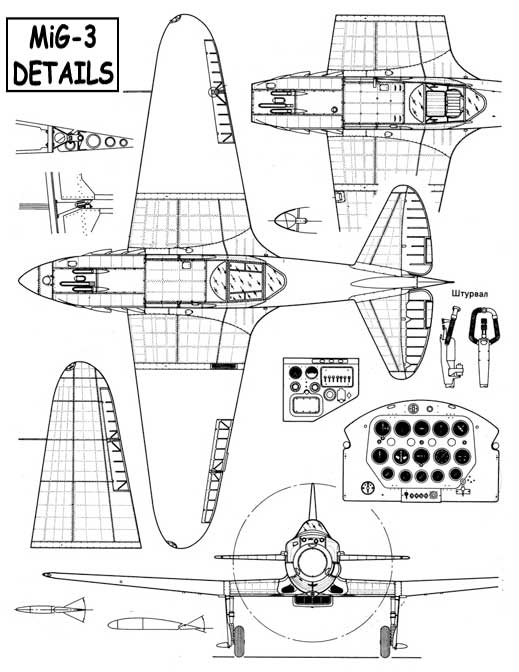 Armor was fitted behind the pilot's seat in the MiG-3. This was 8 mm think and later increased to 9 mm. Cooled exhaust gas was feed to the fuel tanks to act as a fire suppressant. |
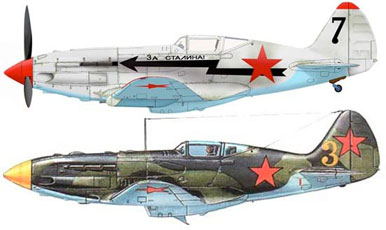 The
MiG-3 differed mainly from its direct predecessor as regards its
engine and in range. Indeed, while keeping the same structure
and general design of a single-engine single seater, with low
wings. retractable undercarriage and liquid-cooled engine, the
MiG-3 used a more powerful V-12 Mikulin AM 35A engine and was
equipped with a supplementary fuel tank which improved its operational
capabilities.
The
MiG-3 differed mainly from its direct predecessor as regards its
engine and in range. Indeed, while keeping the same structure
and general design of a single-engine single seater, with low
wings. retractable undercarriage and liquid-cooled engine, the
MiG-3 used a more powerful V-12 Mikulin AM 35A engine and was
equipped with a supplementary fuel tank which improved its operational
capabilities.
Other minor modifications, which tended to improve the flight performance and maneuverability of the aircraft, were made to the cockpit (which was now equipped with a rear window to enlarge the pilot's field of vision and was completely enclosed), the wing (the rear of which had increased dihedral), the propeller (replaced with one of a more efficient type) and the ventral radiator. The structure of the MiG-3 was still mixed and the skin was in wood and aluminum, like the MiG-1.
The armament, too, was identical: two 7.62 mm ShKas machine
guns, a Beresin 12.7 mm gun and a maximum bomb-load of 200 440
lb. Speed and range, however, were noticeably better: from 390
mph at 22,970 ft altitude to 407 mph at the same altitude, while
the range was almost half as great again as that of the MiG-1. 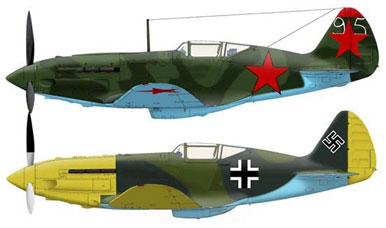
From the time the MiG-3 started operations it immediately showed its real potential. Above 16,400 ft altitude the aircraft gave its best performance and it was fit to face all comers: at lower altitudes, however, it showed a noticeable reduction in speed and maneuverability which meant that it was at a disadvantage compared with the fighters of the Luftwaffe.
Another shortcoming when it was used in battle was the inadequacy of its armament: the two small-caliber machine guns were clearly insufficient: an effort was therefore made to remedy this by installing two 12.7 mm Beresin B's under the wings.
Production of the MiG-3 was short-lived: towards the end of 1941 the assembly lines were closed down, in part because construction of the AM 35A engine was being superseded by the more powerful AM 38 which was intended for the Ilyushin Il-1. The fighter stayed in service until the last months of 1943. At that time it had already been replaced by the more up-to-date Yakovlev and Lavochkin, but it remained useful for tactical high altitude reconnaissance. It was the entry of this new and efficient aircraft which meant that Mikoyan and Gurevich' s next aircraft, the MiG-5, was only a limited success. Being in direct competition with the Lavochkin La-5, the MiG-5 suffered from being outclassed by its contemporary and only a small number were produced, remaining in service for a brief period in 1943.
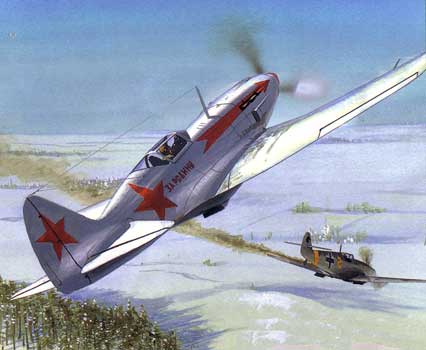
The MiG-5 prototype flew in 1942: it preserved the structure of its predecessor, with the exception of variations made necessary by the adoption of the Shvetsov M 82A radial engine in place of the V-12 AM 35A. The two designers returned to the inline engine in the next model, the MiG-7, the prototype of which appeared towards the end of 1944. The fighter had been commissioned with the specific aim of producing a high-altitude interceptor, able to shoot down German reconnaissance planes. The MiG-7 fulfilled these requirements, but very few were made because by that time the danger from enemy reconnaissance aircraft had diminished. The development of the MiG-7 did play an important part in the next technical advance for high level aircraft: among Soviet aircraft it was the first with a completely pressurized cockpit.
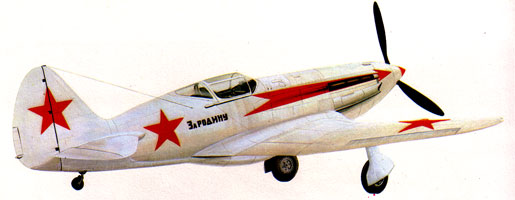 .
.
The slogan painted on the aircraft reads "Za Rodinu"
– "For the Motherland"

|
Artem Mikoyan Artem Mikoyan was half the design team that produced the MiG fighters. Between 1940 and 1970, this outspoken and open minded Armenian was the inspiration behind some of the world's finest fighters. On December 14, 1939, A.T.Mikoyan was assigned so chief designer was formally appointed as assistant of the chief designer on the plant no. 1 but the OKO-1 was subordinated directly to Voronin, not to Polikarpov, and had the right to be turned directly to the government far resolution of operational problems. The OKO-1 received about 40% of the technicians of the Polikarpov bureau, and part of the production team and facilities. Mikoyan was offered to form his own design team in September, but he initially refused because of his lack of projecting experience and his strong position on the Polikorpov's team. In fact, he worked on a commission studying the causes of air accidents, so- he had frequent reasons to contact both designers and production technicians, obtaining great experience and gaining credit thanks to his skills, He was a friend of M.I.Gurevic - then heading the Polikarpov's bureau preliminary design group. |
Specifications
Length: 27 ft 1 in
|
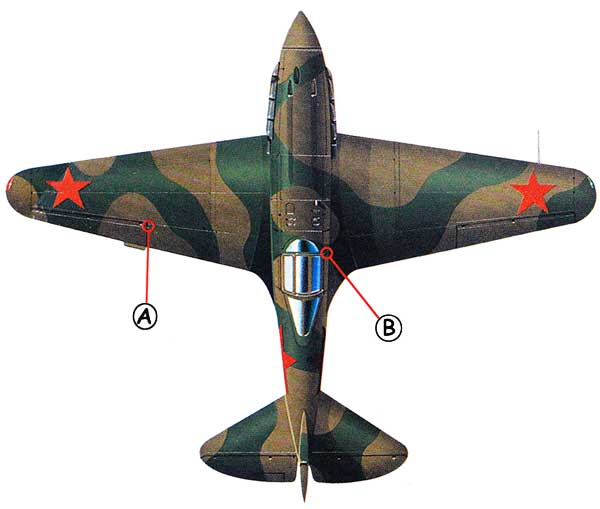 |
|
| A: In an effort to bolster the MiGs poor armament, a BK 12.7 mm (.50 cal.) machine gun was added in an individual pod beneath each wing. | B: Armor was fitted behind the pilot's seat in the MiG-3. This was 8-mm thick, later increased to 9-mm Cooled exhaust gas was fed to the fuel tanks to act as a fire suppressant. |
 |
|||
| A: In the long nose section was the Mikulin AM 35 engine with two 29 gallon fuel tanks. The MiG-3 had a second oil cooler and improved engine cooling compared to the MiG-1. | B: All armament was grouped above the engine, and consisted of a UBS 12.7 mm (.50 cal.). machine gun with 300 rounds and two 7.62-mm (.30 cal.) ShKAS machine guns with 375 rounds each. | C: Like most Soviet aircraft the MiG-3 had an austere cockpit fit, with only 13 instruments and no radio. The pilot sighted his weapons through a PBP-1 gun sight. | D: Although the forward fuselage was made of steel tubing with an alloy stressed skin, the rear fuselage consisted of four pine longerons with a very thin plywood and calico skin. |
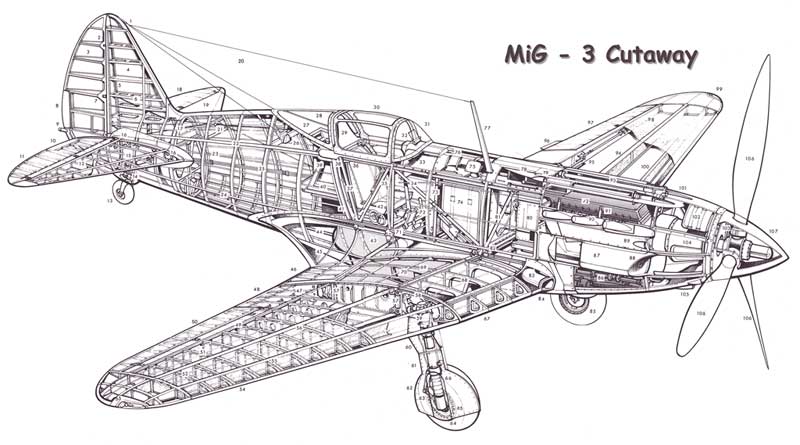 |
This fabulous MiG-3 cutaway comes in a 5MB PDF with key for FREE included in your MyModels folder! |
